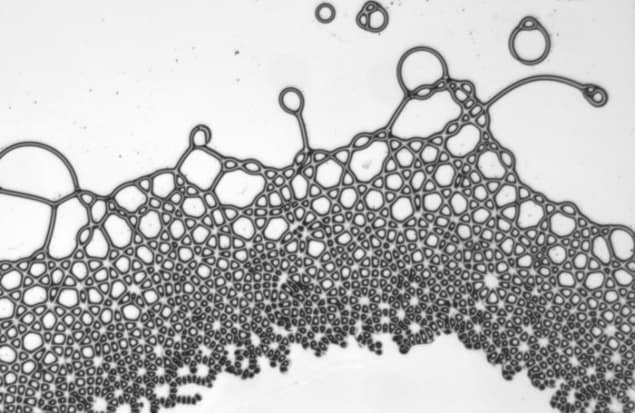Electric fields cause square droplets and liquid lattices to appear in oil mixtures
26 Sep 2021
When a simple system of two liquids is driven out of equilibrium, it can generate a far more diverse array of structures than previously thought, new experiments have shown. The discovery was made by Jaakko Timonen, Nikos Kyriakopoulos and colleagues at Aalto University in Finland, who identified structures including filaments, lattices, and square-shaped droplets, when applying electric fields to thin sheets of different combinations of conductive, polarizable oils.
If two liquids are brought together, they will usually settle into the steady state of thermodynamic equilibrium. Depending on their miscibility and relative densities, they can form uniform mixtures (such as water and ethanol), separated layers (such as oil floating on top of water) – or emulsions such as mayonnaise. Far more interesting behaviour can emerge if these systems are driven out of thermodynamic equilibrium by the application of external forces such as an electric field.
Non-equilibrium behaviours underly a wide array of fascinating phenomena: from the emergence of unexpected patterns within materials, to collective motions of self-propelling microbes. As a result, they are of immense interest across different numerous fields: from physics to biology. With existing theories, however, it can be incredibly challenging to predict the nature of the complex states that emerge.
Polarized oils
To shed new light on two liquid systems, the Aalto team designed a new set of experiments involving several different oils: each with different densities and electrical conductivities; and which become electrically polarized to different degrees when electric fields are applied.
When a thin sheet of any combination of two of the oils was subjected to an electric field, charges would build up at the interface separating them. Through the effect of electrohydrodynamic shearing, these charges were set into motion, driving the entire system out of equilibrium. The result was a wholly unexpected diversity of patterns and shapes.
At low levels of shearing, the researchers identified symmetry breaking at the interface between the oils, creating 1D patterns of corrugation. When shearing was slightly stronger, topological changes at the interface gave rise to microfilaments that rolled and rotated about their axes, and which could connect to form intricate networks.
Strong shearing
Alternatively, the oils could also form 2D lattices – which are virtually unheard of in liquids. When shearing was at its strongest, the system transitioned into square, hexagonal, and doughnut-shaped droplets, which could actively propel themselves forwards.READ MORE

Timonen’s team hope that their discoveries could soon enable researchers to create temporary droplets, filaments, and lattices with well-defined sizes, which could be turned on and off by an applied voltage. If achieved, this could lead to many exciting applications: including controllable optical devices, and the ability to mimic the dynamics of swimming microbes, such as bacteria and algae.
The research is described in Science Advances.
Sam Jarman is a science writer based in the UK
from physicsworld.com 26/9/2021

Δεν υπάρχουν σχόλια:
Δημοσίευση σχολίου